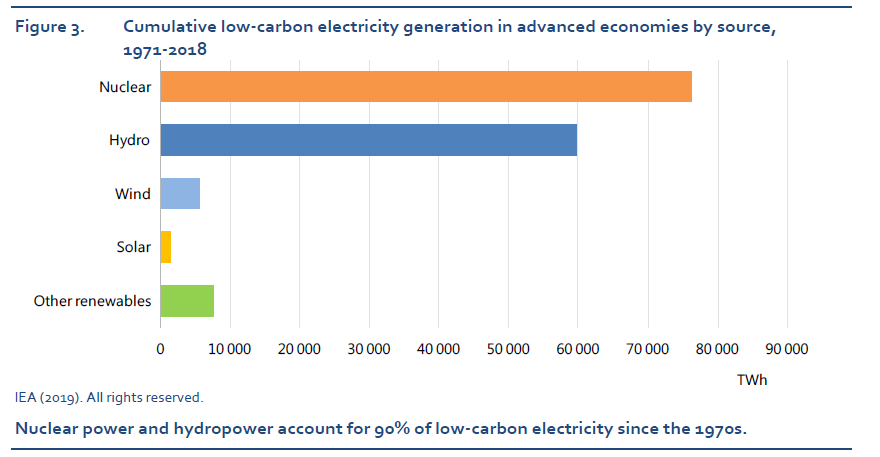International Energy Agency (IEA) says we need nuclear
The International Energy Agency (IEA) plays an important role in looking at the global energy scene. Every year it publishes the World Energy Outlook (WEO) providing important information and analysis to countries to support their development of energy policy. Over the years, the focus of the WEO has been to consider alternative scenarios to business as usual to provide guidance on what is needed for the world to decarbonize. In various iterations of its report, it called this scenario the 2 Degree scenario, the 450 scenario (for 450 ppm) and now the Sustainable Development Scenario (SDS). Every year the IEA states the importance of decarbonizing our energy systems, and every year it laments how difficult this will be.
Yet, it rarely talks much about the role that nuclear power
currently plays and must play in the future to achieve this decarbonization
goal. Rather the analysis generally focuses
its attention on massive increases in renewables which does reduce the fossil
footprint but not nearly enough as fossil fuels remain more than half of global
energy supply in 2040. The only path to
meet its scenario emission targets then requires policies that reduce energy
demand. Consider the following figure
from the 2018 WEO that shows renewables doubling, coal being cut in half while
gas retains its position as an important fuel in the SDS scenario – with the
balance of the carbon reduction due to reduced demand in 2040 for this scenario
– 2% less than 2017 and much less than currently projected in the New Policy
Scenario (which projects a 26% increase to 17,715Mtoe). Do we really think that the world will use
less energy in 2040 than it does today?

But that was then, and this is now. At the Clean Energy Ministerial (CEM) meeting in Vancouver last month, the IEA issued a report “Nuclear Power in a Clean Energy System” and the message is unequivocal. The IEA is stating that to decarbonize our energy systems, WE NEED NUCLEAR!
The report notes that “lifetime extensions of existing
nuclear power plants are crucial to getting the energy transition back on track.” And “that without nuclear investment,
achieving a sustainable energy system will be much harder.” In fact, “a collapse in investment in
existing and new nuclear plants in advanced economies would have implications
for emissions, costs and energy security.”
Of more importance it says that “achieving the clean energy transition with less nuclear power is possible but would require an extraordinary effort.” And even though it talks about the economic challenges facing nuclear power, both existing and new, it also notes that “offsetting less nuclear power with more renewables would cost more” and that “taking nuclear out of the equation results in higher electricity prices for consumers.”
Finally, it concludes with a message to world governments, “strong
policy support is needed to secure investment in existing and new nuclear plants.”
This is the strongest support given to nuclear power by the IEA in memory. Even back in 2014 when it had 3 chapters on nuclear in the WEO, it was a reluctant supporter. At that time it noted that “Nuclear power is one of the few options available at scale to reduce carbon-dioxide emissions while providing or displacing other forms of baseload generation”, but also started its discussion with “Provided waste disposal and safety issues can be satisfactorily addressed,” while never discussing the challenges that other forms of energy face.
To their credit, in this new report, there is no discussion of these traditional nuclear bugaboos with the focus clearly on why nuclear is needed, why we are better off with nuclear in the system and then suggests policy options for government to make this happen going forward.
The report shows the role nuclear power plays in mitigating carbon emissions is nothing new as over the last 50 years it has displaced more carbon than any other electricity source. Yes, that’s correct. No other electricity source has displaced as much carbon as nuclear. So, just imagine what can be achieved in the next 50 years.

This IEA report is a turning point in the global discussion. As one government official said, this is the kind of report that moves the world. I am not sure how far – but it is definitely a very important step in the right direction. Because one thing is now absolutely clear – if the world wants to decarbonize, the quickest and lowest cost option is to ensure an increasing role for nuclear energy.